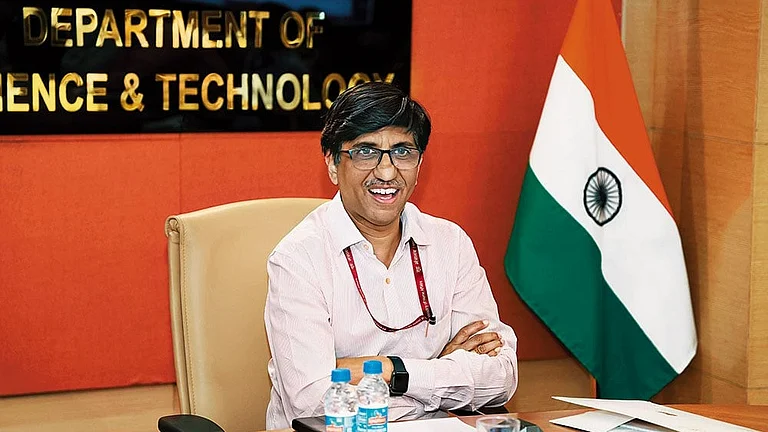On a quiet campus in South Mumbai, picture a scientific lab boasting of a tangle of cryogenic tubes and signal processors, where a sleek machine hums at near-absolute zero. It’s here, beneath the layers of electromagnetic shielding and timeworn optimism, that an indigenous quantum computer — expected to be India’s first — is quietly coming to life.
At the heart of this effort is Rajamani Vijayaraghavan, a veteran physicist at the Tata Institute of Fundamental Research (TIFR), who began tinkering with superconducting circuits more than a decade ago—long before “quantum” entered the mainstream tech lexicon.
He completed his Bachelors degree in Physics from St. Stephen's College, Delhi University in 1999. He spent two more years at the University of Cambridge before embarking on a PhD at Yale.
After his postdoctoral work at University of California, Berkeley, Vijayaraghavan returned to India and joined TIFR to start a new laboratory. His lab is now home to a six-qubit quantum system, a critical milestone in India’s slow but steady race to catch up with global quantum computing progress.
“The final technology is not yet fully developed, which means we have an opportunity to catch up if we invest and move research in the right direction,” said Vijayaraghavan.
To many, quantum computing sounds like science fiction. Unlike classical computers, which process information using bits that are either 0 or 1, quantum computers use qubits that can be 0, 1, or both at the same time—thanks to the counterintuitive principles of quantum mechanics.
Picture a computer so powerful it could crack the encryption protecting your bank account, a military communication system, or even a nation’s nuclear launch codes—in minutes. That’s the promise, and peril, of quantum computing. And the world’s biggest tech firms and governments are locked in a race to build them.
Governments are already preparing for what they call “Q-Day”—the moment when quantum computers will be able to break most digital encryptions. That threat has national security hawks on the edge.
And no country is betting bigger than China. Beijing has poured more than $15 billion into quantum tech—more than the US and EU combined. Its scientists have already made headlines with the Zuchongzhi quantum chip, and its quantum satellite, Micius, was the first to beam entangled particles from space. These are not just science experiments—they’re early moves in a strategic power shift. If China gets there first, it could rewrite the rules of cybersecurity, espionage, and even trade.
Meanwhile, US technology majors like Microsoft, Amazon, Google, and IBM are also pouring billions into the race.
Microsoft recently announced a major breakthrough with its Majorana 1 chip, named after a famously mysterious Italian physicist. This chip uses a new kind of qubit—called a topological qubit—which is designed to be far more stable than what’s been possible so far. Stability matters because today’s quantum machines are notoriously error-prone and finicky. Think of trying to run software on a calculator that glitches every few seconds. The tech giant’s innovation could make scalable quantum computing—quantum computers that can actually run useful programs—viable sooner than expected.
Back home, India’s homegrown six-qubit system in TIFR, funded by the Defence Research and Development Organisation (DRDO), represents a rare blend of ambition and indigenous engineering. Tata Consultancy Services (TCS) has built the web interface for remote access. Despite challenges posed by the pandemic, the project has advanced significantly. By August last year, successful end-to-end testing verified that submitted quantum circuits were processed correctly. Since then, efforts have focused on optimizing performance and ensuring reliability before public access.
With no official launch date yet, the system is currently in its final testing phase. Meanwhile, the National Quantum Mission is also progressing, with Vijayaraghavan leading one of the selected teams working on superconducting qubit-based quantum computers.
However, the project is still awaiting full financial approval, which is expected in April.
Vijayaraghavan’s Reflections
The National Quantum Mission, launched in 2023, aims to consolidate these efforts by bringing together research teams and expanding funding. He leads one of the teams selected for building quantum computers using superconducting qubit technology.
Various teams composed of multiple scientists across several institutes have been selected with funding ranging from Rs. 50 to 150 crores per team. While funding for quantum research has increased, administrative hurdles remain. The introduction of the government’s ‘Just-in-Time’ funding model has added new layers of complexity.
“We no longer receive actual money in our institute’s bank account,” he said in an interview with Outlook Business.
Instead, researchers are granted a spending limit, and each transaction must be individually approved, triggering a process that involves multiple bureaucratic steps.
“Funds are released from the Reserve Bank of India and trickle down through the system. It’s been a struggle figuring it out.” Researchers have spent months navigating the new system, which still has unresolved issues. “Hopefully, by the time the main funding arrives, these glitches will be sorted out.”
Despite the challenges, he remains optimistic about the future of quantum research in India.“Today, there is a growing community of scientists working in cutting-edge areas that were previously unrepresented in India,” he said.
The Road to Quantum Computing
While the country is still catching up with global leaders, efforts led by institutions like TIFR have set the foundation for a thriving quantum research environment.
He recalls the uncertainties he faced when he first chose his research area. “At that time, I wasn’t thinking too strongly about it,” he says. “I had no idea whether quantum computing research would even take off in India or whether there would be any institutional support.”
Having left for higher studies soon after his undergraduate education, he had little connection with the Indian research community. However, after completing his PhD, he started visiting institutes across the country, assessing their research environments and funding availability. “The critical question for me was: can I continue my research in India? If the facilities and support existed, I would return.”
A decade ago, setting up a quantum lab in India required significant investment, and Vijayaraghavan’s journey was no exception. When he started his work in 2012, superconducting qubits were largely unexplored in India. “The first hardware platform for quantum computing research in India began with my lab,” he explains.
Establishing a basic lab required around a million dollars, but he was fortunate to receive timely funding and institutional backing from TIFR and its parent organization, the Department of Atomic Energy (DAE). “Unlike many others who struggled, I had a smooth start because TIFR was cooperative, and within two years, I had received nearly 80% of my budget,” he said.
Despite the initial momentum, challenges soon caught up. By 2017, the Department of Science and Technology (DST) launched a major funding program called Quantum Enabled Science and Technology (QuEST) with an unprecedented allocation of Rs 200 crore.
However, delays in approval meant that the first tranche of funds reached only a fraction of the selected scientists by 2019. “For many of us, the funding came almost three years after the initial call for proposals,” he recalls. By the time the remaining funds arrived in late 2020, the pandemic had disrupted supply chains, restricted imports, and shut down research facilities.
“We finally had the money, but we couldn’t spend it,” he says, highlighting the paradox many researchers faced.
In mid-2020, the government brought in a policy for overhauling government procurement to promote self-reliance. It required institutions using public funds to prioritize Indian-made goods. For imports above Rs 5 lakh, researchers had to seek waivers before issuing global tenders—a process that delayed critical equipment purchases.
Despite such hurdles, India’s quantum research ecosystem has since expanded, with more labs across the country working on various aspects of the field. “When I started, there were no other labs working on superconducting qubits,” Vijayaraghavan notes.
“Now, we have five dedicated labs and many others conducting parallel research,” he adds.
Establishing a quantum lab today is significantly more expensive than it was a decade ago. “Back then, my lab required about a million dollars. Now, if you start from scratch, it could cost close to $5 million,” he estimates. This financial barrier has been a key reason why quantum research in India has remained limited. “In many cases, researchers who wanted to start quantum projects simply didn’t get the funds to build the necessary infrastructure.”
While Vijayaraghavan’s initial years were marked by rapid progress, the past few years have been slower due to funding delays, policy shifts, and external disruptions. “The funding landscape has improved, but actually utilising the funds has become more difficult,” he says.
Transforming Vision into Reality
India’s position in quantum computing is often questioned, but the real concern is not about being late, it’s about being in the race at all. While global leaders like the US have invested decades into fundamental research, India’s efforts have gained momentum only in the last decade. Despite the gap, researchers believe the country still has a chance to carve a niche in quantum technology.
Vijayaraghavan emphasises that the key is not just participation but achieving leadership in certain aspects of quantum technology.
A crucial challenge remains workforce development. While the US has been training talent for over 30 years, India has only been doing so seriously for the past five. “How many experts can you train in such a short period?” he points out, acknowledging the existing talent drain. Many of India’s brightest researchers move abroad for better opportunities, further widening the gap.
To reverse this trend, he believes India must offer competitive salaries, better funding, and an enabling research environment. “If I train someone and they become invaluable within a year, global institutions will make them better offers. We need to create compelling reasons for them to stay.”
Although retaining talent in India’s working sector remains a challenge, as many trained researchers move abroad for better salaries and research opportunities, the issue isn’t just funding but also creating the right environment to keep them engaged in forefront work.
Vijayaraghavan highlights the limitations of government-funded academic institutions. “There are rules about salaries, making it difficult to compete globally when attracting the best talent.” He acknowledges that while competitive pay is crucial, it is only part of the solution. Creating opportunities in India is equally important. “A decade ago, if someone wanted to work on superconducting qubits, they had no option in India. Now, at least, there are labs and programs.”
Beyond academia, engaging the private sector is necessary. Industries can offer better compensation, attracting skilled professionals. Government initiatives like the National Quantum Mission are also making a difference by improving infrastructure and research funding. “If we can offer competitive salaries along with a strong research ecosystem, we have a better chance of retaining talent,” he says.
On the other hand, the quantum of funding has improved, but the flow of funds and the rules governing their expenditure have made research operations more complex. Over the past decade, procurement regulations have become more rigid, making it difficult for scientists to obtain essential equipment. “Funding has increased, but spending the money has become enormously difficult,” he noted.
A key obstacle has been the government’s restrictive import policies. Under the Atmanirbhar Bharat initiative, institutions must now justify any imported equipment valued between Rs 5 lakh and Rs 200 crore. “For scientific equipment, this is a major roadblock,” Vijayraghavan explained.
“Most tools are not manufactured in India, yet we are required to prove their unavailability every time we make a purchase and the time-consuming documentation process delays research and disrupts project timelines,” he said.
Additionally, the government’s e-marketplace (GeM), meant to curb corruption, has instead added inefficiencies, forcing research institutions to buy through a portal with unclear product details. “We spend enormous amounts of time navigating the system, only to eventually seek special approvals when it fails to meet our needs,” he added.
These procurement hurdles pose a challenge to the success of India’s Rs 6,000 crore National Quantum Mission. The initiative aims to position India as a leader in quantum technology, but researchers warn that excessiveness could undermine its impact.































